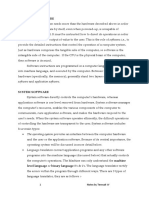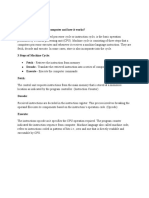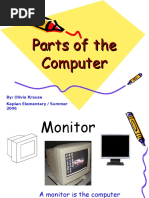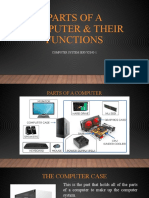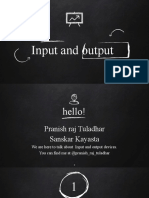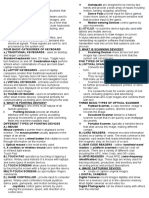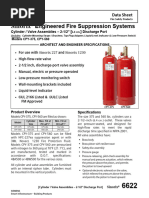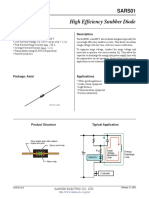85%(13)85% found this document useful (13 votes)
29K viewsElements of Computer System
The document discusses the key elements of a computer system, including hardware, software, and peopleware. It provides details on common input devices like keyboards, mice, scanners, cameras and touch screens. It also describes various output devices such as monitors, printers and speakers. The document provides examples of different types of printers, screens and ports that allow connection of additional components to a computer system.
Uploaded by
heartpassion25Copyright
© Attribution Non-Commercial (BY-NC)
Available Formats
Download as PDF, TXT or read online on Scribd
85%(13)85% found this document useful (13 votes)
29K viewsElements of Computer System
The document discusses the key elements of a computer system, including hardware, software, and peopleware. It provides details on common input devices like keyboards, mice, scanners, cameras and touch screens. It also describes various output devices such as monitors, printers and speakers. The document provides examples of different types of printers, screens and ports that allow connection of additional components to a computer system.
Uploaded by
heartpassion25Copyright
© Attribution Non-Commercial (BY-NC)
Available Formats
Download as PDF, TXT or read online on Scribd
You are on page 1/ 3
ELEMENTS OF COMPUTER SYSTEM Handheld Electronic Organizers – are small mobile
computers that accept input through a penlike
Computer System is a complete, working computer. The instrument called a stylus that is used to write n the
computer system includes not only the computer, but also any computer’s screen.
software and peripheral devices that are necessary to make the Microphone – device for converting sound wave into
computer function. electrical energy.
Web Camera – is a camera that is in some way
1. Hardware connected to the World Wide Web, or Internet.
2. Software Trackpad – a small, touch-sensitive pad, usually a
3. Peopleware / Liveware couple of inches square, which acts as an alternative
to a mouse on some notebook/palmtop computers. It
works by sensing fingertip pressure.
HARDWARE Joystick – a manual control consisting of a vertical
handle that can move freely in two directions; used as
It is best described as a device that is physically connected to your an input device to computers or to devices controlled
computer or something that can be physically touched. by computers.
Touch Screen – a type of display screen that has a
touch-sensitive transparent panel covering the screen.
INPUT DEVICE – any device that allows the person to Instead of using a pointing device such as a mouse or
communicate information to the computer / gives information light pen, finger is used to point directly to objects on
to the computer system so that it can perform its tasks the screen.
Light Pen – an input device that utilizes a light-
Bar Code Reader – is an input device used to scan a sensitive detector to select objects on a display
Bar Code Reader pattern of lines using optical screen. A light pen is similar to a mouse, except that
sensing techniques the line patter is coded information with a light pen the pointer can be moved to selects
about the item to which it relates (e.g. the price and objects on the display screen by directly pointing to
description of an item of merchandise). the objects with the pen.
Digital Camera – record images in digital form. Stylus – a pointing and drawing device shaped like a
Digitizing Tablet – an input device that enables you pen. Stylus is used with a digitizing tablet or touch
to enter drawings and sketches into a computer. A screen.
digitizing tablet consists of an electronic tablet and a Sensor – is a device, which responds to an input
cursor or pen. A cursor (also called a puck) is similar quantity by generating a functionally related output
to a mouse, except that it has a window with cross usually in the form of an electrical or optical signal.
hairs for pinpoint placement, and it can have as many Optical Character Recognition – permits users to
as 16 buttons. input printed or typewritten documents with a scanner.
Keyboard – is the most commonly used input device, Pen-Based Computing – involves the use of a
similar to a typewriter keyboard that is a part of a special pen on a monitor surface, as with a personal
terminal that is connected to a computer elsewhere. digital assistant.
Mouse – which has a ball on its underside, is rolled on Voice Recognition System – activated by user’s
a flat surface, usually the desk on which the computer voice after voice has been programmed into the
sits / a device that controls the movement of the computer; currently accepts limited number of vocal
cursor or pointer on a display screen, originally commands.
designed by Xerox
Trackball – it is a variation on the mouse, but it is an
upside mouse-you roll the ball directly with your hand. OUTPUT DEVICE - It is anything that allows the computer to
Touchpad – your finger as the pointer/ is a pressure- communicate information to the user.
sensitive pad that is smaller, more accurate, thinner,
and less expensive to build than a trackball. Monitor – It is used to display soft copy output.
Scanner – a device that can read text or illustrations
printed on paper and translate the information into a Varieties of Screens
form the computer can use. A scanner works by
digitizing an image – dividing it into a grid of boxes 1. Cathode Ray Tube (CRT) – It uses a technology
and representing each box with either a zero or a one, called raster scanning, a process of sweeping
depending on whether the box is filled in. electron beams across the back of the screen.
2. Liquid Crystal Display (LCD) – A flat display
Categories of Scanners often seen on watches and calculators,
sometimes used in laptop computers.
1. Flatbed Scanner – It is a typically scans one sheet at 3. Plasma – consists of ionized neon / gas (plasma)
a time, although some offers an attachment for sealed between two glass plates. One glass
scanning multiple sheets. plate encases a set of horizontal wires and the
Advantage: It can be used to scan bound other a set of vertical wires. The images
documents, such as pages from books and produced by plasma display are generally very
other bulky items. clear, detailed, and not subject to the flicker
associated with monochrome monitors. Plasma
2. Sheetfeed Scanner – Motorized rollers feed the sheet displays are generally more expensive than their
across the scanning head. CRT counterparts.
Advantage: It is usually designed to fit neatly
between the keyboard and the monitor. Printer – It is a device that produces information on
paper output.
3. Handheld Scanner – The least expensive and least
reliable of the three, is a handy portable option Types of Printer
Disadvantage: It is often difficult to get a good
scan because the user must move the scanner in 1. Non-Impact Printer – places an image on a page
a straight line and fixed rate. without physically touching the page.
1.1 Laser Printer – use a light beam to help
Optical Mark Reader – was designed initially to read transfer images to paper
penciled or graphic information on exam answer 1.2 Ink-Jet Printer – Which spray ink from a
sheets. multiple jet nozzles, can print in both black and
white and several different of colors of ink to
produce excellent graphics.
2. Impact Printer – uses some sort of physical types of ports. Internally, there are several ports for
contact with the paper to produce an image, connecting disk drives, display screens, and
physically striking paper, ribbon, and print keyboards. Externally, personal computers have ports
hammer together. for connecting modems, printers, mice, and other
2.1 Daisy Wheel Printer peripheral devices. Examples: Universal Serial Bus
2.2 Dot Matrix Printer (USB), Parallel (PS2), Serial.
2.3 Cain Printer
2.4 Band Printer Expansion Slots – a connector in a computer into
which an expansion card can be plugged. The
Voice Output – It is typically used when an inquiry is connector supplies power to the card and connects it
followed by a short reply, such as a balance or flight to the data bus, address bus and control signals of the
time. Many businesses have found another creative motherboard. Examples: ISA (International Serial
uses for voice output over the telephone. Architecture), PCI (Peripheral Component Interface),
Speaker – an output device producing sounds. AGP (Accelerated Graphics Port).
Speech Synthesizer – increase a message as
temporary output that computer users hear. Bus – a collection of wires through which data is
Microfilm or Microfiche – are reduced sized transmitted from one part of a computer to another.
photographic reproductions of printed information on
film cards. The cards can be read using microfiche
readers and printed using microfiche printers. Registers – are temporary storage areas for
Plotter – a device that draws pictures on paper based instruction or data
on commands from a computer. Plotters differ from - They are not part of the memory rather they are
printers in that they draw lines using a pen. As a special additional storage locations that offer the
result, they can produce continuous lines, whereas advantage of speed.
printers can only simulate lines by printing a closely
spaced series of dots. Multicolor plotters use different- Microprocessor – a miniaturized central processing
colored pens to draw different colors. unit can be etched on a chip, a tiny square of silicon.
- It is usually expressed in megahertz (MHz).
INPUT/OUTPUT DEVICES – a piece of hardware that is used Bus lines – is a set of parallel electrical paths,
for both providing information to the computer and receiving
usually copper tracing on the surface of the
information
motherboard, which internally transports data from
one place to another within the computer system.
Disk Drive – a computer hardware that holds and
spins a magnetic or optical disk and reads and writes
Cache – is a relatively small block of very fast
information on it.
memory designed for the specific purpose of
Hard Disk Drive – a rigid magnetic disk mounted speeding up the internal transfer of data and software
permanently in a drive unit. instructions.
Optical Disc – a direct-access disk, which has
information recorded on it with a laser beam that MACHINE CYCLE
burns pits into its surface.
Modem – the modem modulates the computer output Control Unit ALU
to an acceptable signal for transmission and then DECODE EXECUTE
demodulates the signal back for computer input.
SYSTEM UNIT – the main part of a personal computer. The
system unit includes the chassis, microprocessor, main
memory, bus, and ports, but does not include the keyboard or Main Memory
monitor, or any peripheral devices.
FETCH STORE
Central Processing Unit (CPU) – it is the brains of
the computer. Sometimes referred to simply as the
processor or central processor, the CPU is where
most calculations take place The first two steps together are called the actual
o Control Unit – supervises or monitors the instruction time, or I-Time or Instruction cycle
functions performed by the entire computer or I-cycle.
system according to conditions set forth by the
stored program. 1. The control unit fetches the instruction form the
o Arithmetic/Logic Unit – the part of a computer memory.
that performs all arithmetic computations, such 2. The control unit decodes the instruction and
as addition and multiplication, and all comparison directs that the necessary data be moved from
operations. The ALU is one component of the memory the arithmetic/logic unit.
CPU.
o Memory Unit – is somewhat like an electronic Steps 3 and 4 together are called execution time,
filing cabinet capable of holding data or or E-Time or Execution cycle or E-cycle.
instructions.
3. The arithmetic/logic unit executes the
Motherboard – the main circuit board of a arithmetic/logical instruction, given as the actual
microcomputer. The motherboard contains the operation on the data.
connectors for attaching additional boards. Typically, 4. The arithmetic/logic unit stores the result of this
the motherboard contains the CPU, BIOS, memory, operation in memory or in a register.
mass storage interfaces, serial and parallel ports,
expansion slots, and all the controllers required to STORAGE DEVICES
control standard peripheral devices, such as the
display screen, keyboard, and disk drive. Collectively, 1. Primary Storage – also called as main memory; a
all these chips that reside on the motherboard are non-volatile, temporary type of storage.
known as the motherboard’s chipset. Examples:
RAM – Random Access Memory
Ports – an interface on a computer to which you ROM – Read Only Memory
connect a device. Personal computers have various PROM – Programmable ROM
EEPROM – Electronic Erasable Programmable DATABASE MANAGEMENT - It is the
ROM management of a collection of interrelated
facts-handles data in several ways.
2. Secondary Storage – also called as auxiliary Examples: DBaseIII, MS Access, Foxbase,
memory, a volatile, permanent type of storage FoxPro
Examples:
Hard disk GRAPHICS - Visual information is usually
Floppy Disk more compelling than a page of numbers.
Optical Disk (Compact Disks) Examples: Adobe Photoshop, Corel Draw
COMMUNICATIONS - It can hook a phone
up to the computer and communicate with
SOFTWARE the computer at the office or access data
stored in another computer in another
location. Examples: Win Popup
It I the planned, step-by-step set of instructions required to turn data
DESKTOP PUBLISHING – to create
into information-that makes a computer useful.
personalized cards, business cards,
letterheads, etc.
SYSTEM SOFTWARE – consists of programs designed to Examples: Hallmark, Disney’s, etc.
facilitate the use of the computer by the user. Any software
required supporting the production or execution of application CAI/CAD/CAM – Computer Aided
programs but which is not specific to any particular Instructions, Computer Aided Design,
application. Computer Aided Manufacture
1. Operating System - an important part of the system
software which tells the computer how to perform
functions such as how to load, store and execute an
PEOPLEWARE
application program an how to transfer data between
the input/output devices and main memory.
Examples: MS-DOS, MAC-OS, all versions of
Windows, UNIX This component is made up of the people responsible for
maintaining, operating, programming, and analyzing the output
2. Programming Languages – software which are used generated by the computer system.
to create software.
Examples: ADA, LISP, C, Pascal, Basic, etc. Computer Operator – works in the computer room and is
responsible for a number of different tasks.
3. Compilers / Translators – is a system program that Data Library- is usually located close to the computer
converts the English-like instructions used by room and usually staffed by a data librarian.
computers programmers into the machine-readable Data Entry Personnel – are responsible for entering large
code used by the hardware. volumes of data into the computer system.
Examples: Assembly, COBOL System Analysts – review current or proposed
applications within a company to determine if the
4. Utility Program – perform such standard tasks as applications should be implemented using a computer.
organizing and maintaining data files, translating Computer Programmers – design, write, test and
programs written in various languages to a language implement specialized programs that process data to
acceptable to the computer. computer.
Examples: Text Editor, Defragmenter, File Database Administrator – an important function within the
Compressor such as WinZip, etc. information system department is the management of data.
Management Information System Department (MISD)
APPLICATION SOFTWARE - is applied to a real-world task, - Management within an information systems department
it can be used to solve a particular problem or to perform a varies depending on the size and complexity of the
specific task. department.
1. Customized – typically created to perform a particular Persons inside MISD
task. 1. Systems Manager – overseas the activities in the system
Examples: payroll, monitoring, registration, point of analysis and design area of the department.
sales, video rentals, etc. 2. Programming Manager – is in charge of all programmers
within the department.
2. Packaged – purchased programs which are required 3. Operation Managers – overseas the operational aspects
for common business and personal applications of the department such as scheduling, maintenance, and
Examples are the following: operation of the equipment.
4. Information System Department Manager – is in charge
WORD PROCESSING - it is the most of the entire department and may have the title Vice
widely used personal computer software President of Information System, or Chief Information
that used for memos, reports, Officer.
correspondence, minutes of meetings, and
anything else that someone can think of to EDP (Electronic Data Processing)
type.
Examples: MS-Word, WordStar, EDP, an infrequently used term for what is today usually called
WordPerfect, AmiPro "IS" (information services or systems) or "MIS" (management
information services or systems), is the processing of data by a
ELECTRONIC SPREADSHEETS - It is computer and its programs in an environment involving
made up of columns and rows of numbers electronic communication. EDP evolved from "DP" (data
have been used at business tools for processing), a term that was created when most computing
centuries. input was physically put into the computer in punched card form
Examples: MS Excel, Lotus 1-2-3, and output as punched cards or paper reports.
QuattroPro
You might also like
- Wartsila DP Maintenance Course Manual - Rev ANo ratings yetWartsila DP Maintenance Course Manual - Rev A305 pages
- Q # 1 What Is Machine Cycle in Computer and How It Works?100% (1)Q # 1 What Is Machine Cycle in Computer and How It Works?4 pages
- Parts of A Computer & Their Functions CSS Lesson1100% (1)Parts of A Computer & Their Functions CSS Lesson123 pages
- Parts and Functions of The Computer Keyboard83% (6)Parts and Functions of The Computer Keyboard1 page
- SHS 1 Lesson 2 - Information Processing Cycle100% (1)SHS 1 Lesson 2 - Information Processing Cycle25 pages
- Classification of Computers According To Technology and Size90% (20)Classification of Computers According To Technology and Size12 pages
- Module 006: Web Browsers: What Is The World Wide Web (WWW) ?No ratings yetModule 006: Web Browsers: What Is The World Wide Web (WWW) ?8 pages
- 27 Main Parts of Motherboard and Its Function100% (1)27 Main Parts of Motherboard and Its Function30 pages
- Introduction To Information and Communications Technology (Ict)No ratings yetIntroduction To Information and Communications Technology (Ict)22 pages
- Advantages and Disadvantages of Peer To Peer Network100% (1)Advantages and Disadvantages of Peer To Peer Network3 pages
- Operating System Services: Made By: Nikita Biswas Class: B.SC CS III100% (1)Operating System Services: Made By: Nikita Biswas Class: B.SC CS III14 pages
- Computer System, Input, and Output Device: Lesson 2No ratings yetComputer System, Input, and Output Device: Lesson 24 pages
- Yeni Turkcell 2013 Hybrid Sistem ParametreNo ratings yetYeni Turkcell 2013 Hybrid Sistem Parametre16 pages
- Water-Cooled Water Chillers: Standard Type Heat Recovery Type Brine TypeNo ratings yetWater-Cooled Water Chillers: Standard Type Heat Recovery Type Brine Type11 pages
- Latitude-E6420-Xfr - Service Manual - En-UsNo ratings yetLatitude-E6420-Xfr - Service Manual - En-Us81 pages
- 9 Meters 384.000 360º Manual: Apolo Start As4006No ratings yet9 Meters 384.000 360º Manual: Apolo Start As40066 pages
- CPY-375, CPY-560 Cylinder Valve Assemblies - 2-1-2 Inch Discharge Port, Data SheetNo ratings yetCPY-375, CPY-560 Cylinder Valve Assemblies - 2-1-2 Inch Discharge Port, Data Sheet4 pages
- Oki C5000 Series of Printers Maintenance ManualNo ratings yetOki C5000 Series of Printers Maintenance Manual264 pages
- The Series Gabion Mesh Machines Have Been Designed To Make Gabion Mesh of Various Widths and Mesh SizesNo ratings yetThe Series Gabion Mesh Machines Have Been Designed To Make Gabion Mesh of Various Widths and Mesh Sizes2 pages
- RTD & Thermocouple Wire & Cable: Internet: EmailNo ratings yetRTD & Thermocouple Wire & Cable: Internet: Email7 pages
- Passenger Elevators (Machine-Room-Less System) For Usa: Mitsubishi Electric US, Inc. Elevator/Escalator DivisionNo ratings yetPassenger Elevators (Machine-Room-Less System) For Usa: Mitsubishi Electric US, Inc. Elevator/Escalator Division14 pages
- Diodo Tarjeta Logica Del 1 Disco Duro Wester Digital de 500gb Modelo WD5000AAKX - 083CA1 Del DVR WesrNo ratings yetDiodo Tarjeta Logica Del 1 Disco Duro Wester Digital de 500gb Modelo WD5000AAKX - 083CA1 Del DVR Wesr10 pages
- Drive Train - Axles: Same Deutz-Fahr ItaliaNo ratings yetDrive Train - Axles: Same Deutz-Fahr Italia15 pages
- No Round-Over: Project Design: Rod Cox, St. Paul, IowaNo ratings yetNo Round-Over: Project Design: Rod Cox, St. Paul, Iowa1 page
- SECTION 02822 Chain Link Fences and Gates Part 1 - GeneralNo ratings yetSECTION 02822 Chain Link Fences and Gates Part 1 - General4 pages
- Conductive Plastic Potentiometric Position Transducers KL SeriesNo ratings yetConductive Plastic Potentiometric Position Transducers KL Series178 pages
- RC2-100B Screw Compressor: Standard Compressors Accessories PortsNo ratings yetRC2-100B Screw Compressor: Standard Compressors Accessories Ports1 page





